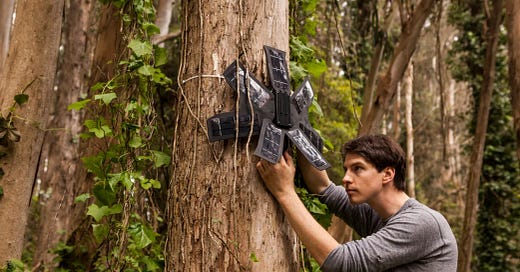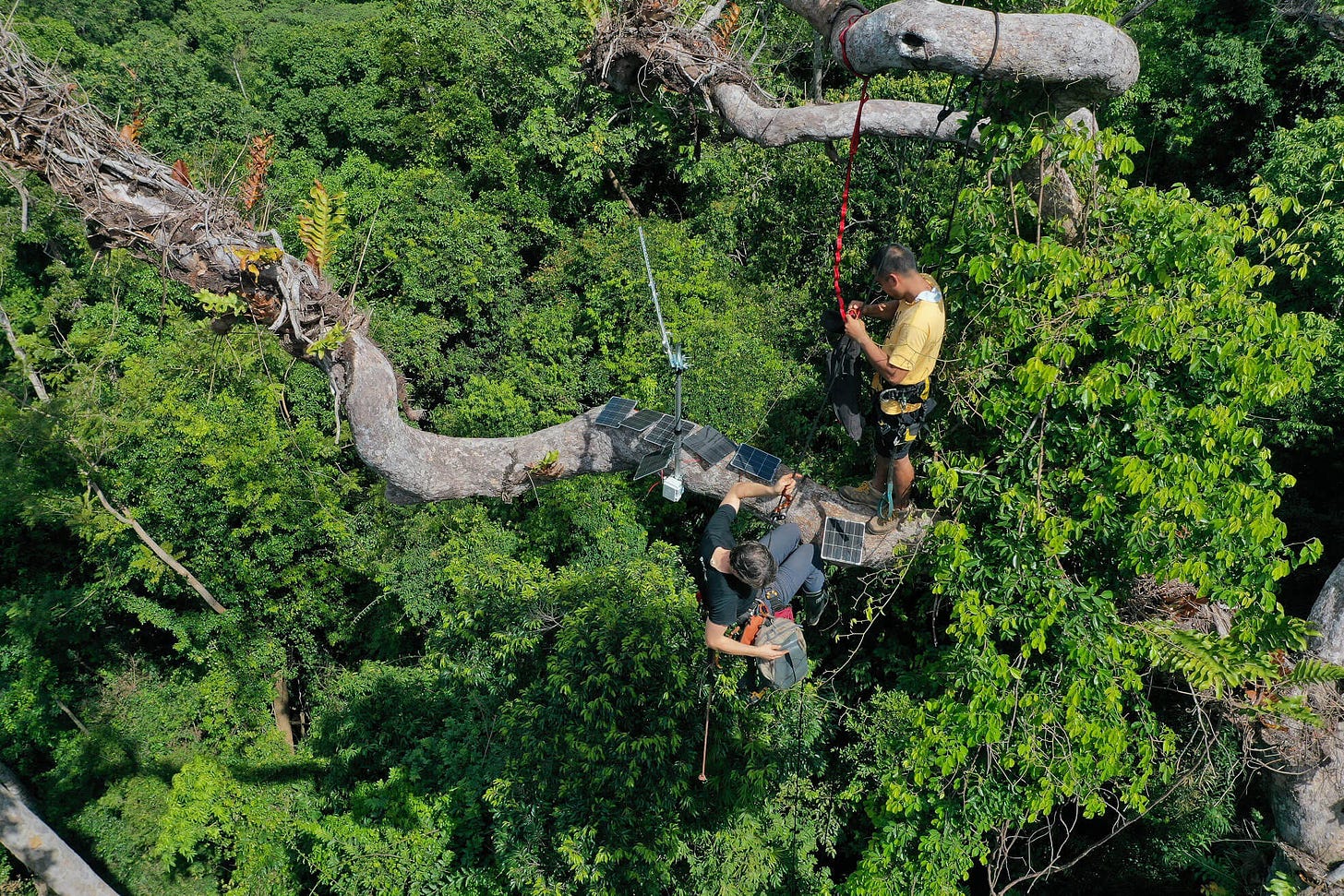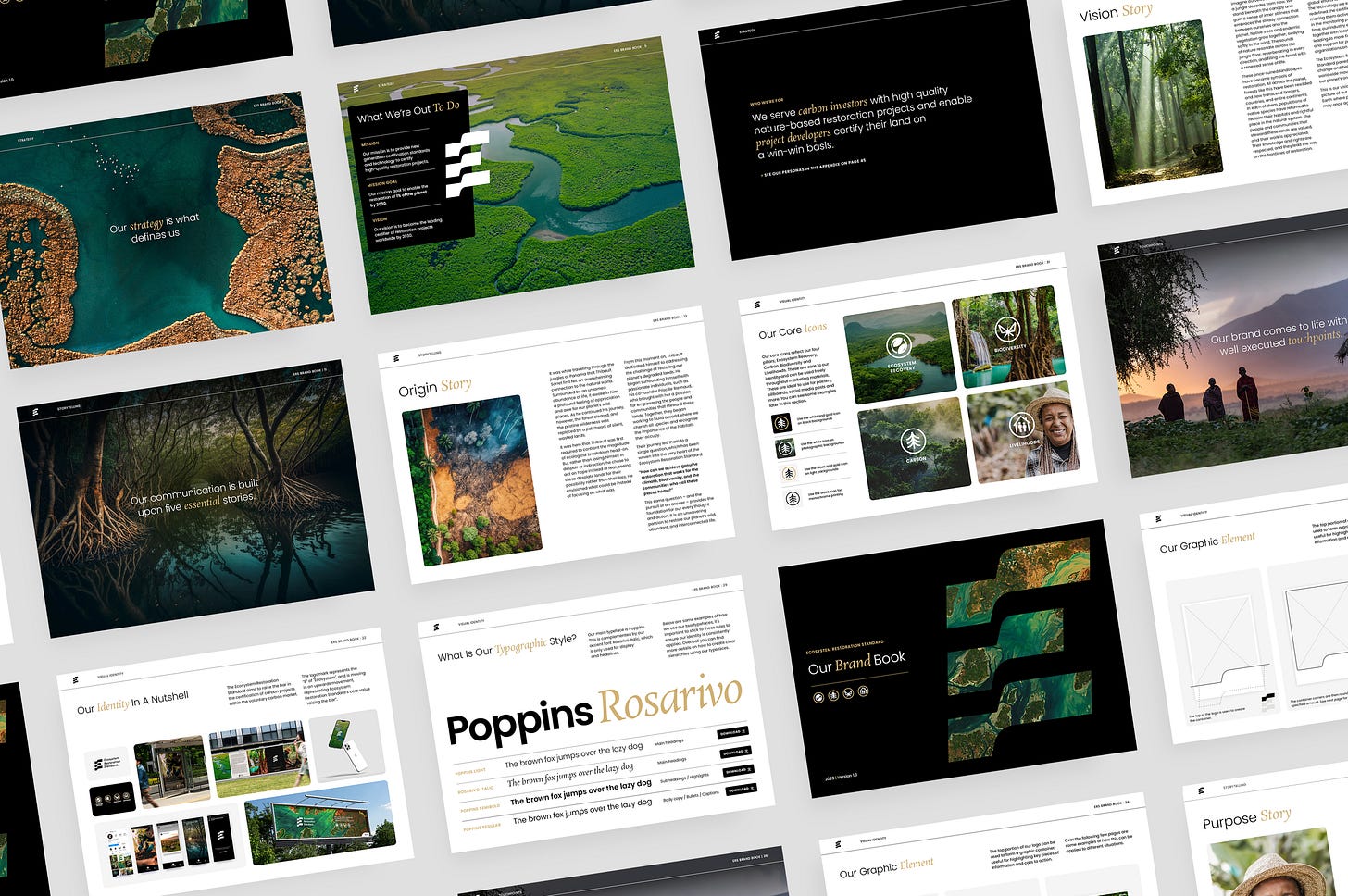Unleashing the Potential of Business to Protect Critical Ecosystems
Advice on Entrepreneurship, The Power of Sculpting a Vision Story, and Envisioning A Future for Our Forests with ERS
Welcome to Changemakers, the official newsletter of Brighter Future.
Thank you to everyone for being a part of this journey and joining us for this edition of the Brighter Future newsletter. Each edition will include insights on brand storytelling, advice from conversations with investors and founders, and deep dives into different aspects of planet-driven business. These newsletters will be released on the first and third Thursdays of each month.
This week, we’re focusing on our love for the critical ecosystems of the world, including rainforests. In this edition, we’re discussing advice for climate startups with Topher White, sharing insights on vision stories from our work with ERS, and highlighting the power of using stories to envision a brighter future.
Check out this week’s topics…
Advice for Young Entrepreneurs with Topher White of Rainforest Connection
The Power of Envisioning A Better Tomorrow for Our Rainforests
Developing A Vision for the Future with ERS
Tickets to Storytelling Workshop
Unlocking the Potential of Climate Technology with Topher White
Topher White is the founder of Rainforest Connection, a non-profit tech startup building technology to help communities worldwide protect their areas from illegal logging, poaching, and other threats. The organisation also studies remote ecosystems using devices called “guardians,” which are placed in treetops to capture the sounds of a given part of a forest 24 hours per day
During Topher’s Origin Story, he shared some advice from his experience on building a business as a young entrepreneur in the climate space.
Check out Topher’s full interview with the link below.
Is there any advice you might like to give to young entrepreneurs just starting a climate startup or people who are considering building a business in the climate space?
The climate space is particularly tricky when addressing issues and finding solutions. It's important to focus on building and solving a problem that is close to you and is something you can understand and relate to. However, climate change can be more complicated because our lives intersect with climate change in many ways, such as energy and transportation.
It's important to remember that others will be disproportionately affected by climate change but have more power to address it than we do. We should try to help them by understanding their issues and working with them.
It means finding the people who can make the most difference in climate tech and trying to solve their problems, realising that these issues may change over time.
Climate change is a complex issue involving both state and corporate actors. It's easy to point fingers and ask who is responsible for causing it and who has the power to stop it. But solutions to address climate change are not likely to come from a single source— they’ll probably be messy, and could involve many different approaches, like a combination of renewable energy, nuclear power, and conservation efforts.
Ultimately, addressing climate change will require a cultural shift among humanity towards adaptation and understanding of how to live differently. This change will be messy and may not have a clear outcome, but it will be necessary for the survival of our planet.
Instead of debating over what is the right or wrong solution, it's important to allow for a diversity of approaches. Climate change solutions don't have to be grand or large; they can also be local and small. For example, a single family protecting 1000 hectares of forest can have a greater impact than a team of six at a clean tech company. It's important to remember that only some solutions need validation or recognition to make a difference. Every solution counts, and we should give them a shot.
The most important thing is to focus on creating something that can be seen and understood in the future, something that future generations will appreciate or envy. We don't need to overthink or over-engineer everything; sometimes, the best ideas come when we are open and receptive to inspiration.
It's important to take the time to listen and realise that what we say doesn't matter as much as what we create. That is the true meaning of being alive.
The Power of Envisioning a Better Tomorrow for Our Rainforests
For decades, visual images of the rainforest have captured the imagination of millions of people around the world. From the picturesque vistas of BBC’s Planet Earth series to the beloved characters of Disney’s Jungle Book, these visions of luscious forest landscapes have played a significant role in our cultural conversation.
At the same time, our planet's rainforests are under grave threats from deforestation, habitat loss, and wildfire. The sanctity of these beloved ecosystems is being eroded in pursuit of economic gain, the promise of livelihoods, and destructive natural resources.
Storytelling plays an essential role in constructing visions of beauty and grandeur that paint a picture of a better tomorrow for these critical ecosystems.
These visions of the rainforest are the driving force behind the work of organisations such as Topher’s Rainforest Connection, who are working to ensure these magical places are protected from these grave threats. These organisations use these visions of the rainforest and other ecosystems as the benchmark for their work, a destination that makes every step in the journey worthwhile.
This ability to provide this benchmark and vision for the future is why vision stories are critical elements of an organisation's efforts to address environmental issues.
Over the years, we’ve worked with several companies who have used these picturesque visions of the future to build organisations that prioritise living in harmony with nature, provide a more equitable future for people, and uplift communities around the world.
We’ve watched as these stories have helped these organisations align their goals and ambitions with the future, providing employees, investors, and audiences with a reason to support their work.
Read more about the purpose of organisational stories in our insights blog.
Case Study: Developing a Vision for the Future of the World’s Forests with ERS
One of the vision stories we’ve developed was with ERS - an organisation that certifies ecosystem restoration projects worldwide to help empower efforts to combat climate change, uplift biodiversity, and improve livelihoods.
Alongside their founder, Thibault Sorret, we developed a powerful vision story that places the reader in a vision of the future where our critical ecosystems have been protected by the local communities who steward them.
Check out the ERS vision story and case study below.
To understand our vision, we imagine ourselves walking through a jungle decades from now. We stand beneath the canopy and gain a sense of inner stillness that embraces the steady connection between ourselves and the planet. Native trees and endemic vegetation grow together, swaying softly in the wind. The sounds of nature resonate across the jungle floor, reverberating in every direction, and filling the forest with a renewed sense of life.
These once-ruined landscapes have become symbols of restoration. All across the planet, forests like this have been rewilded and now transcend borders, countries, and entire continents. In each of them, populations of native species have returned to reclaim their habitats and rightful place in the natural system. The people and communities that steward these lands are valued, and their work is appreciated. Their knowledge and rights are respected, and they lead the way on the frontlines of restoration.
The recovery of these lands began with the introduction of our standard, which elevated global efforts toward restoration. The technology we employed redefined the certifier's role, making them active participants in the monitoring process. Over time, our industry evolved to work together with local communities, leading to more financing and support for projects and organisations on the ground.
The Ecosystem Restoration Standard paved the way for change and helped lead a worldwide movement to restore our planet’s once-degraded lands. This is our vision of the future, a picture of our potential, a wilder Earth where people and nature, may once again, thrive together.
Sign Up For Beta-Testing for the Brighter Future Branding Course
We’re looking for volunteers to participate in beta-testing for the Brighter Future DIY Brand Strategy course before it's released to the public. This is a free opportunity to work through the content, structure, and overall experience of the program to provide feedback.
If you are interested, let us know by contacting our team below. We’d be happy to share more about the beta-testing process and provide a bit more information on what we are looking for in feedback
As we will only accept a limited amount of beta testers, contact us soon.
Storytelling Workshop
Remember to sign up to join Aaron Leaman, the Founder of Brighter Future, on Friday, October 11, 2024, at 17:00 BST, for a presentation where we will explore how to use these stories to shape the future of your planet-driven organisation.
Aaron will be discussing how to uncover your brand’s narrative and use these origin and vision stories to find investors, build brand loyalty, and attract top-tier talent.
Use the link below with the promotional code CHANGEMAKERS to register for the event. Make sure to sign up soon because spots are limited.
Let’s Tell Your Story
We’ve got some openings on our books for consultations meetings for organisations interested in our brand-building and storytelling packages.
If you are looking to develop a planet-driven brand identity that elevates your impact on the world, book a discovery consultation call with us below.
Thanks for joining us this week, we’ll be back with another edition of Changemakers in two weeks.
Cheers,
The Brighter Future Team









